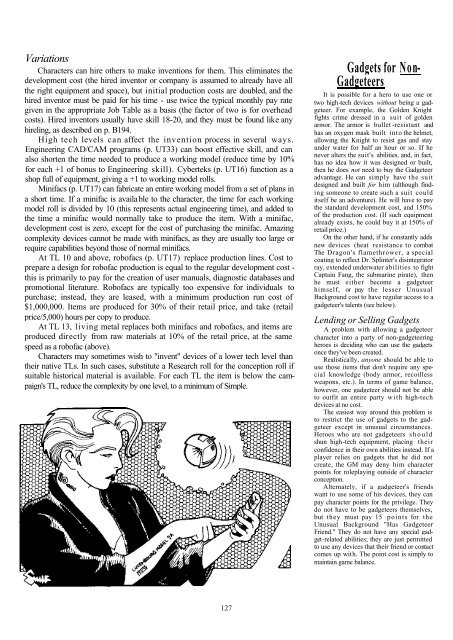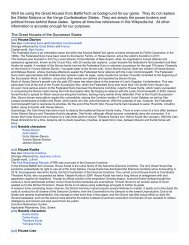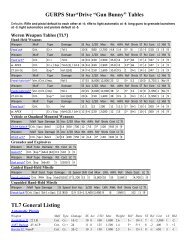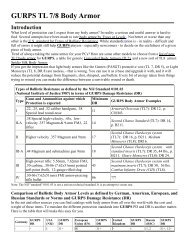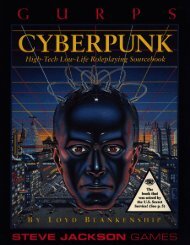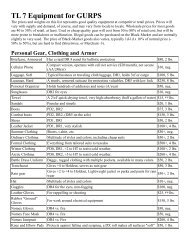GURPS - Compendium 1..
GURPS - Compendium 1..
GURPS - Compendium 1..
You also want an ePaper? Increase the reach of your titles
YUMPU automatically turns print PDFs into web optimized ePapers that Google loves.
Variations<br />
Characters can hire others to make inventions for them. This eliminates the<br />
development cost (the hired inventor or company is assumed to already have all<br />
the right equipment and space), but initial production costs are doubled, and the<br />
hired inventor must be paid for his time - use twice the typical monthly pay rate<br />
given in the appropriate Job Table as a basis (the factor of two is for overhead<br />
costs). Hired inventors usually have skill 18-20, and they must be found like any<br />
hireling, as described on p. B194.<br />
High tech levels can affect the invention process in several ways.<br />
Engineering CAD/CAM programs (p. UT33) can boost effective skill, and can<br />
also shorten the time needed to produce a working model (reduce time by 10%<br />
for each +1 of bonus to Engineering skill). Cyberteks (p. UT16) function as a<br />
shop full of equipment, giving a +1 to working model rolls.<br />
Minifacs (p. UT17) can fabricate an entire working model from a set of plans in<br />
a short time. If a minifac is available to the character, the time for each working<br />
model roll is divided by 10 (this represents actual engineering time), and added to<br />
the time a minifac would normally take to produce the item. With a minifac,<br />
development cost is zero, except for the cost of purchasing the minifac. Amazing<br />
complexity devices cannot be made with minifacs, as they are usually too large or<br />
require capabilities beyond those of normal minifacs.<br />
At TL 10 and above, robofacs (p. UT17) replace production lines. Cost to<br />
prepare a design for robofac production is equal to the regular development cost -<br />
this is primarily to pay for the creation of user manuals, diagnostic databases and<br />
promotional literature. Robofacs are typically too expensive for individuals to<br />
purchase; instead, they are leased, with a minimum production run cost of<br />
$1,000,000. Items are produced for 30% of their retail price, and take (retail<br />
price/5,000) hours per copy to produce.<br />
At TL 13, living metal replaces both minifacs and robofacs, and items are<br />
produced directly from raw materials at 10% of the retail price, at the same<br />
speed as a robofac (above).<br />
Characters may sometimes wish to "invent" devices of a lower tech level than<br />
their native TLs. In such cases, substitute a Research roll for the conception roll if<br />
suitable historical material is available. For each TL the item is below the campaign's<br />
TL, reduce the complexity by one level, to a minimum of Simple.<br />
Gadgets for Non-<br />
Gadgeteers<br />
It is possible for a hero to use one or<br />
two high-tech devices without being a gadgeteer.<br />
For example, the Golden Knight<br />
fights crime dressed in a suit of golden<br />
armor. The armor is bullet -resistant and<br />
has an oxygen mask built into the helmet,<br />
allowing the Knight to resist gas and stay<br />
under water for half an hour or so. If he<br />
never alters the suit's abilities, and, in fact,<br />
has no idea how it was designed or built,<br />
then he does not need to buy the Gadgeteer<br />
advantage. He can simply have the suit<br />
designed and built for him (although finding<br />
someone to create such a suit could<br />
itself be an adventure). He will have to pay<br />
the standard development cost, and 150%<br />
of the production cost. (If such equipment<br />
already exists, he could buy it at 150% of<br />
retail price.)<br />
On the other hand, if he constantly adds<br />
new devices (heat resistance to combat<br />
The Dragon's flamethrower, a special<br />
coating to reflect Dr. Splinter's disintegrator<br />
ray, extended underwater abilities to fight<br />
Captain Fang, the submarine pirate), then<br />
he must either become a gadgeteer<br />
himself, or pay the lesser Unusual<br />
Background cost to have regular access to a<br />
gadgeteer's talents (see below).<br />
Lending or Selling Gadgets<br />
A problem with allowing a gadgeteer<br />
character into a party of non-gadgeteering<br />
heroes is deciding who can use the gadgets<br />
once they've been created.<br />
Realistically, anyone should be able to<br />
use those items that don't require any special<br />
knowledge (body armor, recoilless<br />
weapons, etc.). In terms of game balance,<br />
however, one gadgeteer should not be able<br />
to outfit an entire party with high-tech<br />
devices at no cost.<br />
The easiest way around this problem is<br />
to restrict the use of gadgets to the gadgeteer<br />
except in unusual circumstances.<br />
Heroes who are not gadgeteers should<br />
shun high-tech equipment, placing their<br />
confidence in their own abilities instead. If a<br />
player relies on gadgets that he did not<br />
create, the GM may deny him character<br />
points for roleplaying outside of character<br />
conception.<br />
Alternately, if a gadgeteer's friends<br />
want to use some of his devices, they can<br />
pay character points for the privilege. They<br />
do not have to be gadgeteers themselves,<br />
but they must pay 15 points for the<br />
Unusual Background "Has Gadgeteer<br />
Friend." They do not have any special gadget-related<br />
abilities; they are just permitted<br />
to use any devices that their friend or contact<br />
comes up with. The point cost is simply to<br />
maintain game balance.<br />
127


